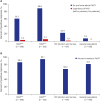1. Labarga P. New update of the DHHS guidelines for adults and children. AIDS Rev. 2015; 17(2):122.
2. Consolidated guidelines on the use of antiretroviral drugs for the treating and preventing HIV infection: recommendations for a public health approach - second edition. Updated 2016. Accessed August 14, 2017.
http://www.who.int/hiv/pub/arv/arv-2016/en.
3. Goldschmidt RH. Preexposure prophylaxis in the United States: an evolving HIV prevention opportunity. Clin Infect Dis. 2017; 64(2):150–151.

4. Allen E, Gordon A, Krakower D, Hsu K. HIV preexposure prophylaxis for adolescents and young adults. Curr Opin Pediatr. 2017; 29(4):399–406.

5. Grant RM, Lama JR, Anderson PL, McMahan V, Liu AY, Vargas L, et al. Preexposure chemoprophylaxis for HIV prevention in men who have sex with men. N Engl J Med. 2010; 363(27):2587–2599.
6. Baeten JM, Donnell D, Ndase P, Mugo NR, Campbell JD, Wangisi J, et al. Antiretroviral prophylaxis for HIV prevention in heterosexual men and women. N Engl J Med. 2012; 367(5):399–410.
7. Thigpen MC, Kebaabetswe PM, Paxton LA, Smith DK, Rose CE, Segolodi TM, et al. Antiretroviral preexposure prophylaxis for heterosexual HIV transmission in Botswana. N Engl J Med. 2012; 367(5):423–434.

9. Holt M, Lea T, Kippax S, Kolstee J, Ellard J, Velecky M, et al. Awareness and knowledge of HIV pre-exposure prophylaxis among Australian gay and bisexual men: results of a national, online survey. Sex Health. 2016; 13(4):359–365.

10. Kwakwa HA, Bessias S, Sturgis D, Mvula N, Wahome R, Coyle C, et al. Attitudes toward HIV pre-exposure prophylaxis in a United States urban clinic population. AIDS Behav. 2016; 20(7):1443–1450.

11. Wilson E, Chen YH, Pomart WA, Arayasirikul S. Awareness, interest, and HIV pre-exposure prophylaxis candidacy among young transwomen. AIDS Patient Care STDS. 2016; 30(4):147–150.

12. Korea Centers for Disease Control and Prevention. 2016 HIV/AIDS Status Annual Report. Cheongju, Korea: Korea Centers for Disease Control and Prevention;2017.
13. Tripathi A, Ogbuanu C, Monger M, Gibson JJ, Duffus WA. Preexposure prophylaxis for HIV infection: healthcare providers' knowledge, perception, and willingness to adopt future implementation in the southern US. South Med J. 2012; 105(4):199–206.
14. Seidman D, Carlson K, Weber S, Witt J, Kelly PJ. United States family planning providersjkms-33-e91 knowledge of and attitudes towards preexposure prophylaxis for HIV prevention: a national survey. Contraception. 2016; 93(5):463–469.
15. Unni EJ, Lian N, Kuykendall W. Understanding community pharmacist perceptions and knowledge about HIV preexposure prophylaxis (PrEP) therapy in a Mountain West state. J Am Pharm Assoc (2003). 2016; 56(5):527–532.e1.

16. Fonner VA, Dalglish SL, Kennedy CE, Baggaley R, O'Reilly KR, Koechlin FM, et al. Effectiveness and safety of oral HIV preexposure prophylaxis for all populations. AIDS. 2016; 30(12):1973–1983.

17. Marcus JL, Hurley LB, Hare CB, Nguyen DP, Phengrasamy T, Silverberg MJ, et al. Preexposure prophylaxis for HIV prevention in a large integrated health care system: adherence, renal safety, and discontinuation. J Acquir Immune Defic Syndr. 2016; 73(5):540–546.

18. Hosek SG, Rudy B, Landovitz R, Kapogiannis B, Siberry G, Rutledge B, et al. An HIV preexposure prophylaxis demonstration project and safety study for young MSM. J Acquir Immune Defic Syndr. 2017; 74(1):21–29.

19. Havens PL, Stephensen CB, Van Loan MD, Schuster GU, Woodhouse LR, Flynn PM, et al. Decline in bone mass with tenofovir disoproxil fumarate/emtricitabine is associated with hormonal changes in the absence of renal impairment when used by HIV-uninfected adolescent boys and young men for HIV preexposure prophylaxis. Clin Infect Dis. 2017; 64(3):317–325.

20. van de Vijver DA, Nichols BE, Abbas UL, Boucher CA, Cambiano V, Eaton JW, et al. Preexposure prophylaxis will have a limited impact on HIV-1 drug resistance in sub-Saharan Africa: a comparison of mathematical models. AIDS. 2013; 27(18):2943–2951.
21. Liegler T, Abdel-Mohsen M, Bentley LG, Atchison R, Schmidt T, Javier J, et al. HIV-1 drug resistance in the iPrEx preexposure prophylaxis trial. J Infect Dis. 2014; 210(8):1217–1227.

22. Lehman DA, Baeten JM, McCoy CO, Weis JF, Peterson D, Mbara G, et al. Risk of drug resistance among persons acquiring HIV within a randomized clinical trial of single- or dual-agent preexposure prophylaxis. J Infect Dis. 2015; 211(8):1211–1218.

23. Knox DC, Anderson PL, Harrigan PR, Tan DH. Multidrug-resistant HIV-1 infection despite preexposure prophylaxis. N Engl J Med. 2017; 376(5):501–502.

24. Branson BM, Handsfield HH, Lampe MA, Janssen RS, Taylor AW, Lyss SB, et al. Revised recommendations for HIV testing of adults, adolescents, and pregnant women in health-care settings. MMWR Recomm Rep. 2006; 55:RR-14. 1–17.







 PDF
PDF Citation
Citation Print
Print






 XML Download
XML Download